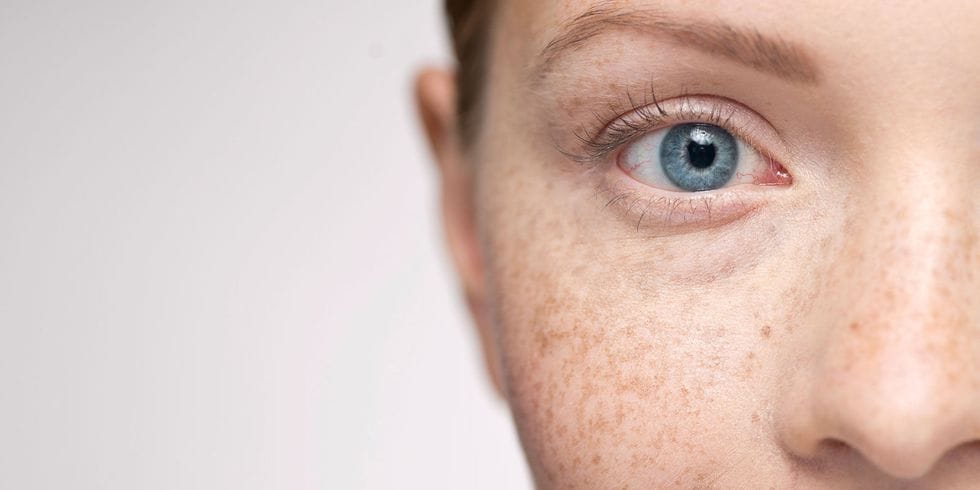For something so commonplace, freckles can be a contentious topic. A genetic gift from Mother Nature, they’ve been both shunned and embraced by the fashion world, with even-toned complexions long deemed ideal, while freckles – real and faux – are sent down the catwalks in cyclical celebrations of diversity. Currently, thanks to the Duchess of Sussex embracing hers for her wedding day (and beyond), freckles are firmly in favour again. But whether you love them or not, there’s more to know than whether they’re considered ‘on trend’.

Harper’s Bazaar UK
Many of us refer to most small, dark marks on the face and body as ‘freckles’, but they’re not all what they seem. Consultant dermatologist Dr Daniel Glass, from The Dermatology Clinic told us that real freckles are most commonly found on younger skin from childhood. “There are three main types of skin pigmentation on the skin, including freckles, however these develop into different skin conditions as we grow older,” he explains. Confused? Here Dr Glass and leading dermatologist Dr Stefanie Williams takes us through the different types of pigmented lesions and marks on your skin so you know what’s what.
1. Freckles
“A freckle is a small, pale to dark brown flat area of skin with a poorly defined border. They are caused by overproduction of melanin pigment by the melanocytes, which is in direct response to UV light exposure. This response occurs in people with a variant of a particular gene called MC1R,” explains Dr Glass. “Visually, people with this variant have red hair and pale skin, and can burn more easily, and far quicker in the sunshine”.
He adds: “Freckles are most prominent on sun‐exposed areas of the skin during the summer months, and tend to fade during the winter season.”
2. Solar lentigines
As we develop and grow, our ‘freckles’ can change to become solar lentigo; a flat, brown mark, explains Dr Glass. “These skin abrasions tend to accumulate with age as a result of sun exposure and, once they appear on the skin, they will not fade in winter months. They are not cancerous and can occur anywhere on the body, but most commonly on the forearms, back of the hands, shoulders and face. Solar lentigines that appear on the back at a later age have been linked to sunburn in this area in childhood. Sun avoidance, use of a broad spectrum, high factor sunscreen, and appropriate clothing lowers the possibility of new lesions emerging in the future.”
If you’re wondering whether your last sunburn could cause these, Dr Williams explains it’s now possible to tell: “Prior to this type of cumulative damage becoming visible to the naked eye, we can make it visible with a Wood’s light, such as the Visia scan.” Should they concern you, treatment can commence thereafter, though fair skin types will be more likely to show cumulative sun damage even with proper care.
3. Lentigo maligna melanoma
“Both freckles and solar lentigines are harmless and completely benign, but it’s is often difficult to recognise the differences between these marks, and a type of skin cancer called lentigo maligna melanoma,” explains Dr Glass.
“This type of skin cancer also presents as a flat, brown or black, irregularly shaped lesion, but it grows very slowly. It occurs on areas of over-sun exposed skin such as the face, neck and forearms. So if you notice a brown spot with multiple colours or an irregular border, it’s important to seek medical advice as soon as possible, as a biopsy may be required.”
4. Melasma
“Melasma is more common in people who tan easily or who have a Mediterranean-type olive complexion,” says Dr Williams. “These larger dark patches of pigmentation are sharply demarcated and bizarrely configured. Melasma may appear as mask-like patches on the cheeks, temples, above the upper lip and/or forehead and is also called a ‘pregnancy mask’ as it often occurs with hormonal changes at this time.”
5. Hyperpigmentation in darker skin tones
“Post-inflammatory hyperpigmentation (PIH) is another type of pigmentation that is more common in darker skin phototypes,” says Dr Williams. “These are stubborn brown patches triggered by inflammation in the skin, such as acne, eczema, or trauma. The melanin pigment in PIH may be located in the epidermis, which is easier to treat, or may drop down into the papillary dermis.”
WHAT TO DO WITH FRECKLED SKIN AND SUN EXPOSURE…
The advice for those with freckled skin is to avoid sun bathing and the use of sun beds, and when out in sunny weather to wear a sunscreen with both high factor (SPF50) UVB protection and UVA protection. “You probably only need 10 or 15 minutes of sun on your face and forearms to get enough vitamin D in the summer,” Dr Glass says, though not all experts are in agreement that you should expose your skin to the sun to get vitamin D. “In the winter many people in the UK are vitamin D deficient and a supplement can be useful,” Dr Glass adds.
TREATMENT OPTIONS?
A post shared by Miami’s #1 Rated Cryotherapy (@cryomiami) on
Treatment isn’t needed for freckles and solar lentigines as they are totally harmless. However, if you’re unhappy with pigmented lesions on your skin, a dermatologist will be able to advise on a range of visual treatments. Dr Glass explains, “these include chemical peels and cryotherapy (liquid nitrogen freezing) to remove the lesions, laser treatments and lightening creams to reduce the appearance and intense pulsed light treatment, which balances uneven melanin levels.”
If you are concerned about any changing pigmented spots on your skin, you should seek advice from your dermatologist, who will also be able to arrange surgical excision of any lesions that may be of concern.
So, there you have it. We say honour, don’t hide, your freckles – but practice safe sun exposure and don’t hesitate to seek medical advice if they change in appearance. Visit your dermatologist for more advise.
From: Harper’s BAZAAR UK



